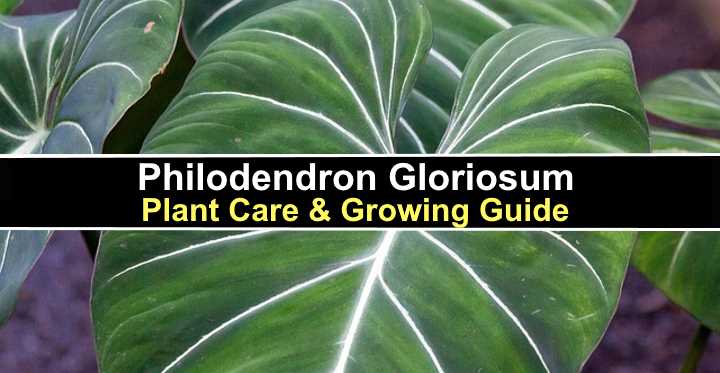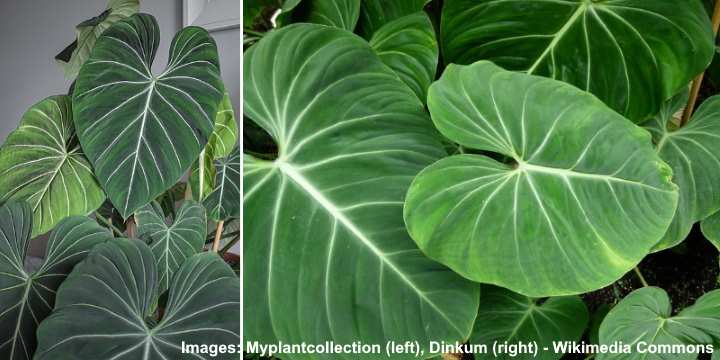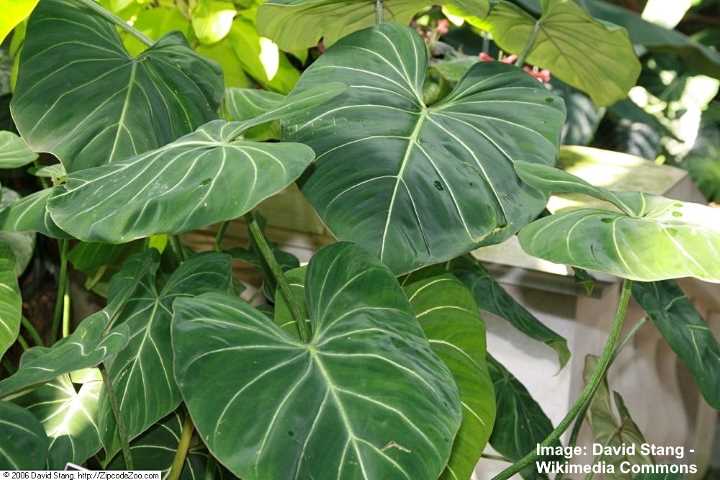Philodendron Gloriosum: Plant Care And Growing Guide (Pictures)

Philodendron gloriosum is a stunning tropical houseplant with large, velvety heart-shaped green leaves and eye-catching creamy-white or pink veins. The magnificent philodendron leaves grow from a creeping rhizome (a thick rootstock that grows horizontally), making the Philodendron gloriosum a type of crawling plant. Despite its exotic, tropical appearance, this philodendron variety is easy to grow at home.
This article is a guide to caring for a Philodendron gloriosum houseplant. You will find handy tips on growing this potted philodendron cultivar. You’ll also find out why the Philodendron gloriosum is such an expensive indoor potted plant.
What is Philodendron Gloriosum?

Philodendron gloriosum has magnificent large velvety leaves that add tropical touch to any home
Philodendron gloriosum is a tropical flowering plant species in the genus Philodendron and aroid family Araceae. It’s classed as a terrestrial plant due to its underground rhizome and crawling foliage. From all the philodendron species, the terrestrial growth habit makes the Philodendron gloriosum a rare type of plant.
Philodendron gloriosum is native to tropical rainforests in South and Central America. This philodendron grows in Colombia, Mexico, Brazil, Peru, Ecuador, and Venezuela. The creeping foliage plants grow on the forest floor, thriving in a warm, humid environment.
Philodendron gloriosum is also a flowering plant. Its flowers look like flowers on most aroid plants. The Philodendron gloriosum flower consists of a flowering spike called a spadix, and a leaf-like bract called a spathe. In their native tropical jungle habitat, philodendrons produce flowers. However, it’s rare for these philodendron houseplants to bloom indoors.
The Philodendron gloriosum is rare among the genus because it’s a terrestrial plant with a rhizome that grows horizontally on the ground. Most types of philodendrons are climbing plants with trailing stems.
Another interesting fact about this philodendron is its cost. The Philodendron gloriosum is an expensive houseplant, costing over a hundred dollars online. Interestingly, most expensive houseplants cost a lot of money due to spectacular variegation—like the Monstera deliciosa ‘Albo Variegata.’ The Philodendron gloriosum is costly partly due to its growth habit and huge velvety heart-shaped leaves with white veins.
Related reading: Philodendron Birkin — a rare tropical houseplant.
How to Care for Philodendron Gloriosum Plant
To care for Philodendron gloriosum, grow the tropical houseplant in bright indirect light and a moist but well-draining light potting mix. Keep the plant in average room temperatures between 65°F and 85°F (18°C – 29°C). Water the philodendron only when the top half of the potting soil is dry. Fertilize monthly during the growing season with a diluted houseplant fertilizer.
Philodendron Gloriosum Leaves
The outstanding feature of the Philodendron gloriosum is its huge cordate (heart-shaped) leaves that feel like velvet. The magnificent matte green leaves have striking pinkish veins that gradually turn creamy white as the plant matures. Philodendron gloriosum leaves grow up to 24” (60 cm) and sit at the end of 3-foot (1 m) long stems.
In its native environment, Philodendron gloriosum creeps along the forest floor, where its leaves can grow larger than the indoor plants—up to 36” (90 cm) long.
Philodendron Gloriosum Growth
Philodendron gloriosum is a slow-growing plant that matures at the height of around 3 ft. (1 m). It can take over a month for a leaf spike to develop into a large velvety cordate leaf with cream-colored veins.
Philodendron gloriosum only grows outdoors in USDA zones 11 and 12.
Philodendron Gloriosum Care Guide
Let’s look in more detail at the best way to care for this spectacular and expensive houseplant indoors.
Philodendron Gloriosum Light Requirements

To care properly for your Philodendron gloriosum houseplant, place it in an indirect sunlight
Philodendron gloriosum thrives in bright light, protected from direct sunlight. Like most tropical indoor plants, the Gloriosum plant can suffer when exposed to intense sunlight. You can grow the philodendron on an east-facing windowsill. If the potted philodendron is near a south- or west-facing window, protect the plant behind a sheer curtain.
Getting enough light allows the Philodendron gloriosum to grow faster and develop larger leaves. Growing in adequate light, the philodendron leaves grow larger and develop the soft, velvety feel that’s characteristic of the Gloriosum plant’s foliage.
One sign that your Philodendron gloriosum isn’t getting enough light is leggy growth. Long stems and sparse foliage or small leaves are indicators that the plant is in too much shade. If you notice slower growth or smaller leaves, it’s best to move the philodendron to a brighter location.
The Best Soil for Growing Philodendron Gloriosum Plants
Philodendron gloriosum grows best in fertile, loose soil that has excellent drainage. Combine two parts peat moss and one part perlite along with worm castings for the ideal philodendron potting mix. Sphagnum peat moss is light and retains moisture. Amending the soilless mixture with perlite helps to improve drainage and prevents root rot. Worm castings can boost the nutrient level.
You can also buy a commercial orchid potting mix and amend it with peat moss and perlite to create an aerated potting medium. Other suitable soil amendments for growing Philodendron gloriosum indoors include charcoal, gravel, pumice, and horticultural coarse sand.
The goal of creating your own houseplant soil mix for philodendrons is to have potting soil that stays consistently moist but never soggy. Water should drain quickly. This fact is essential when growing Philodendron gloriosum as the rhizome can easily succumb to root rot—a growing problem that can spell disaster for your expensive houseplant.
How to Water Philodendron Gloriosum Houseplants
Watering a Philodendron gloriosum properly is a crucial element of good plant care. Only water the Gloriosum plant as often as the top 1” to 2” (2.5 – 5 cm) of soil dries. Then, water the plant thoroughly with filtered, room-temperature water until it drains from the pot’s drainage holes.
Philodendron gloriosum is an expensive houseplant and needs proper care. Overwatering the plant can cause the rhizome root to decay and start to rot. In this case, the costly plant is at risk of dying. In some cases, the only way to save a dying Philodendron gloriosum is to take healthy leaf cuttings to propagate a new plant.
Signs of overwatering a potted philodendron plant include yellowing leaves, mushy roots, or black stems near the soil line. Drooping leaves can also indicate overwatering because the plant can’t absorb enough nutrients.
Underwatering a Philodendron gloriosum can also cause the leaves to become limp and droopy. Overly dry potting soil means that the roots become too dry and can’t transport nutrients to the velvety foliage.
Here are a few tips on watering tropical houseplants such as the Philodendron gloriosum to ensure the best healthy growth:
- Always check the soil for moisture before watering the pricey houseplant.
- Water Philodendron gloriosum once or twice a week in summer and less often in winter.
- Climate conditions—heat, humidity, sunlight, and season—affect the watering frequency, so always check the soil first.
- Philodendron gloriosum growing in terracotta pots requires watering more often than in plastic pots.
- Use the drench and dry method to water Philodendron gloriosum. Drench the soil with room-temperature water and let the top half of the soil dry before watering again.
Philodendron Gloriosum Temperature Range
Philodendron gloriosum thrives in typical household temperatures. Ideally, this philodendron species grows best between 65°F and 85°F (18°C – 29°C). The minimum temperature for the Gloriosum plant is 60°F (16°C). Even though it’s rare for the Philodendron gloriosum to suffer indoors, it’s vital to avoid sudden temperature fluctuations. Keep it out of cold drafts and away from heat vents or radiators.
Philodendron gloriosum doesn’t grow outdoors in USDA zones lower than 11. If you decide to take your potted philodendron outside in the summer, place it in dappled sunlight and protect it from the wind. When nighttime temperatures drop below 60°F (16°C), bring the tropical plant back indoors.
Philodendron Gloriosum Humidity Requirements

Philodendron gloriosum thrives in high humidity of around 60%
Philodendron gloriosum thrives in high humidity of around 60 percent. Thankfully, philodendron plants are adaptable and will grow well in relative humidity of 40 to 50 percent. In drier indoor environments of less than 40 percent air humidity, you will need to increase air moisture levels.
Low humidity at home could be caused by household heating in the winter. This could result in growth issues and poor-quality foliage.
A typical sign that a Philodendron gloriosum lacks humidity is brown tips on the velvety green heart-shaped leaves.
Here are a few handy care tips to get humidity right when growing a Philodendron gloriosum indoors:
- Group plants together to create a more humid micro-climate.
- Use a pebble tray with water and plant the potted Philodendron gloriosum on the pebbles, making sure the pot doesn’t sit in the water.
- Use a room humidifier to boost air moisture levels.
Should you mist Philodendron gloriosum leaves? Misting the soft leaves may increase humidity for a short time. However, in dry-air environments, misting isn’t ideal because it doesn’t raise humidity enough. Misting philodendron leaves and wiping them with a damp cloth can help keep the beautiful leaves free from dust.
How to Fertilize Philodendron Gloriosum for Healthy Growth
Fertilize a Philodendron gloriosum every four weeks during the growing season to encourage large velvety leaves to grow larger and faster. Use a diluted, balanced houseplant fertilizer and mix to the manufacturer’s instructions. Hold off fertilizing houseplants, including Philodendron gloriosum, during the winter.
It’s a good idea to flush the philodendron’s soil every three months to remove any buildup of mineral salts. Pour filtered water through the soil for a minute or so to rinse out any leftover fertilizer. After flushing the soil, wait until it partially dries before watering again and resuming fertilization.
Over-fertilizing houseplants can cause root burn and affect the plant’s growth. So, it’s important to stop fertilizing in the fall and only resume feeding the plant in the spring.
How to Repot Philodendron Gloriosum
Philodendron gloriosum is a slow grower and doesn’t need repotting often. Usually, it’s necessary to repot a Gloriosum plant every two to three years. Repotting a philodendron gives you a chance to refresh the soil, check for root decay, and encourage healthy, fuller growth.
Signs that it’s necessary to repot a Philodendron gloriosum are when it becomes rootbound. You may see that small roots are poking out the container’s drainage holes. Or the philodendron’s growth could have stopped. Additionally, water pooling on the soil’s surface is a sign it’s time to repot the Gloriosum plant.
To repot a Philodendron gloriosum, remove the root ball from the pot. Gently shake excess dirt from the roots. Half-fill a pot with philodendron soil that is one to two sizes larger than the current one. Plant the Philodendron gloriosum so that the thick rhizome part of the root with the leaf stems is above the soil.
Allowing the rhizome to grow on the soil surface prevents root rot and lets the smaller roots grow in the potting soil.
Pruning Philodendron gloriosum
Philodendron gloriosum rarely requires pruning. The main reason for trimming leaves is to remove dead, yellow, or old leaves. Another reason to prune the magnificent Philodendron gloriosum leaves is to propagate new plants.
How to Propagate Philodendron Gloriosum
Propagate a Philodendron gloriosum by taking stem cuttings that are still attached to the rhizome. Propagating a Gloriosum plant this way ensures that some roots are already attached to the stems. This way, you can quickly grow a new Philodendron gloriosum.
Philodendron gloriosum propagation is a great way to gift a friend an exotic houseplant. Also, considering that rooted Philodendron gloriosum cuttings can sell for up to a hundred dollars, your philodendron could earn you some money.
To propagate a Philodendron gloriosum, cut a section of the thick rhizome that has two leaves but leaving at least three leaves on the mother plant. Allow the rhizome cutting to callous for a few hours. Once dry, put the cutting in a pot with moist peat moss and cover with a plastic bag.
Over the next few weeks, keep the soil moist but not soggy by gently misting it. After three or four weeks, roots should have grown. You can then transfer the rooted Philodendron gloriosum cutting to a new pot and grow in a bright location.
Is Philodendron Gloriosum Toxic?
Philodendron gloriosum is a poisonous plant that can harm cats, dogs, and other animals. Philodendron species contain insoluble calcium oxalates that cause oral irritation and swelling, drooling, and difficulty swallowing if ingested.
Pests Affecting Philodendron Gloriosum Growth
Philodendron gloriosum is not prone to infestations by common houseplant pests. However, spider mites, aphids, thrips, and mealybugs can all affect the plant’s growth. To keep your exotic philodendron free from bugs, it’s vital to inspect leaves and stems for signs of plant pests.
Use a neem oil solution to get rid of pests naturally. Make a DIY natural pesticide by mixing 2 tsp. neem oil, 1 tsp. dish soap, and 1 quart (1 l) of water in a spray bottle. Liberally apply the neem oil to both sides of the leaves and stems every seven days. Continue using the neem oil solution until there are no signs of plant bugs.
Diseases Affecting Philodendron Gloriosum Growth
Root rot caused by overwatering is the most common disease affecting Philodendron gloriosum. To prevent root decay, always let the top half of the plant’s soil dry between watering. Then soak the soil with fresh, filtered water. This watering technique keeps the root area moist without becoming soggy.
Suppose a Philodendron gloriosum shows signs of root damage. In that case, it’s vital to remove all damaged roots and parts of the rhizome. Then repot the philodendron in fresh potting soil.
Philodendron Gloriosum Care — FAQs
The Philodendron gloriosum is an expensive indoor plant, and it’s worth looking after it well. Here are some handy tips on ensuring your philodendron plant grows for many years.
Should the Philodendron gloriosum rhizome be above or below the soil?
The thick rootstock of the Philodendron gloriosum should grow partially above the soil. The Gloriosum plant is a creeper that grows horizontally. The upper half of the rhizome should be on the soil’s surface. This allows the plant to grow well and prevents issues with root rot.
Why are the leaves turning yellow on my Philodendron gloriosum?
The typical causes of yellow Philodendron gloriosum leaves are direct sunlight or overwatering. To remedy the issue, you should prune the yellowing leaves to help the plant concentrate its growth in healthy leaves. Then you should adjust your plant care routine to prevent philodendron leaves from turning yellow again.
It’s good to remember that old leaves naturally turn yellow before dying.
How do you revive a dying Philodendron gloriosum?
To help bring a Philodendron gloriosum back to life, it’s crucial to find why the plant is dying. Check for signs of pests, root rot, or fertilizer burn. Use neem oil to eradicate pests from the stems and foliage. Flushing the soil can help reduce stress caused by too much fertilization. If you suspect root rot, remove the decaying plant parts, and repot the philodendron.
Related articles:
